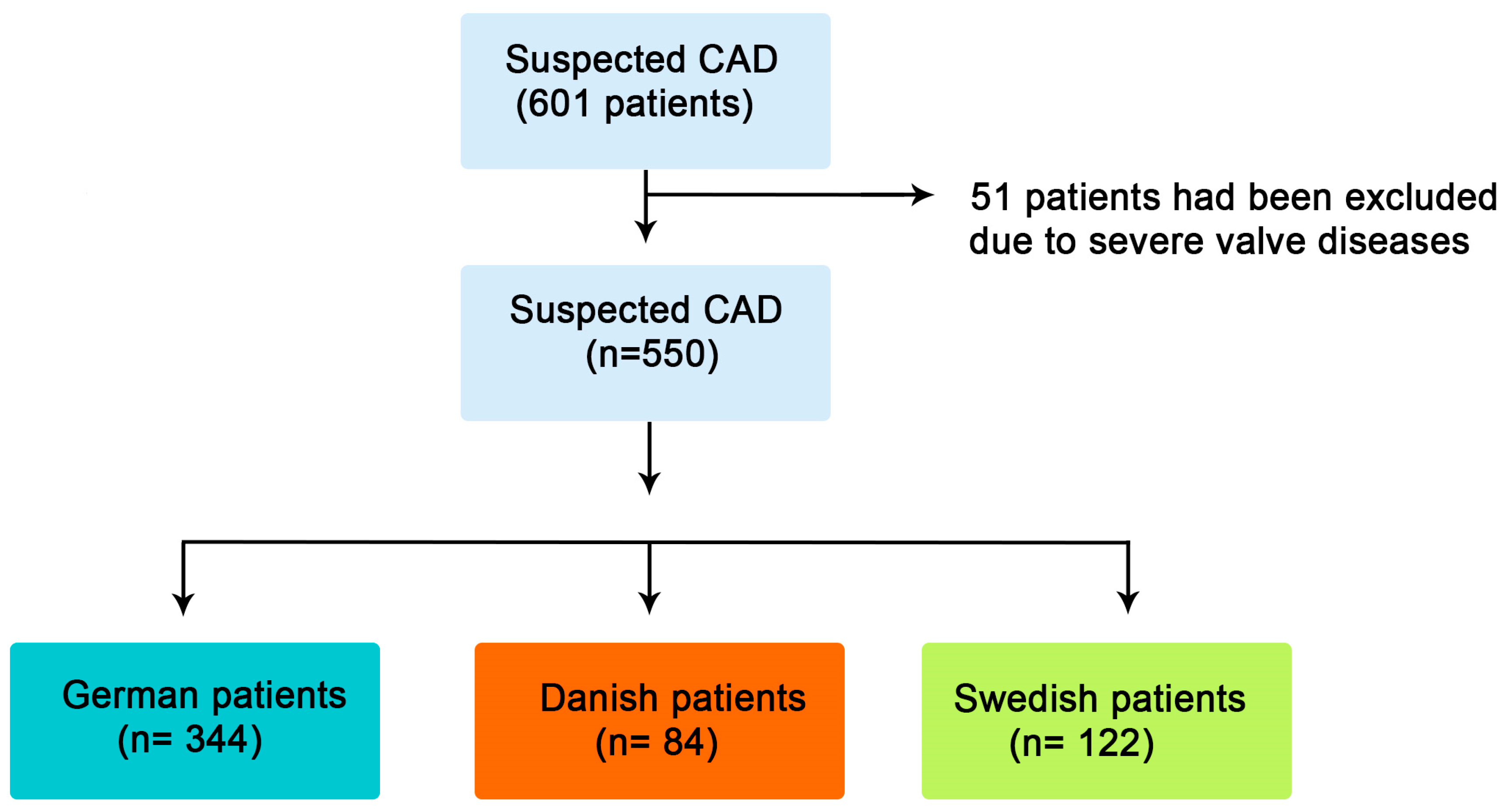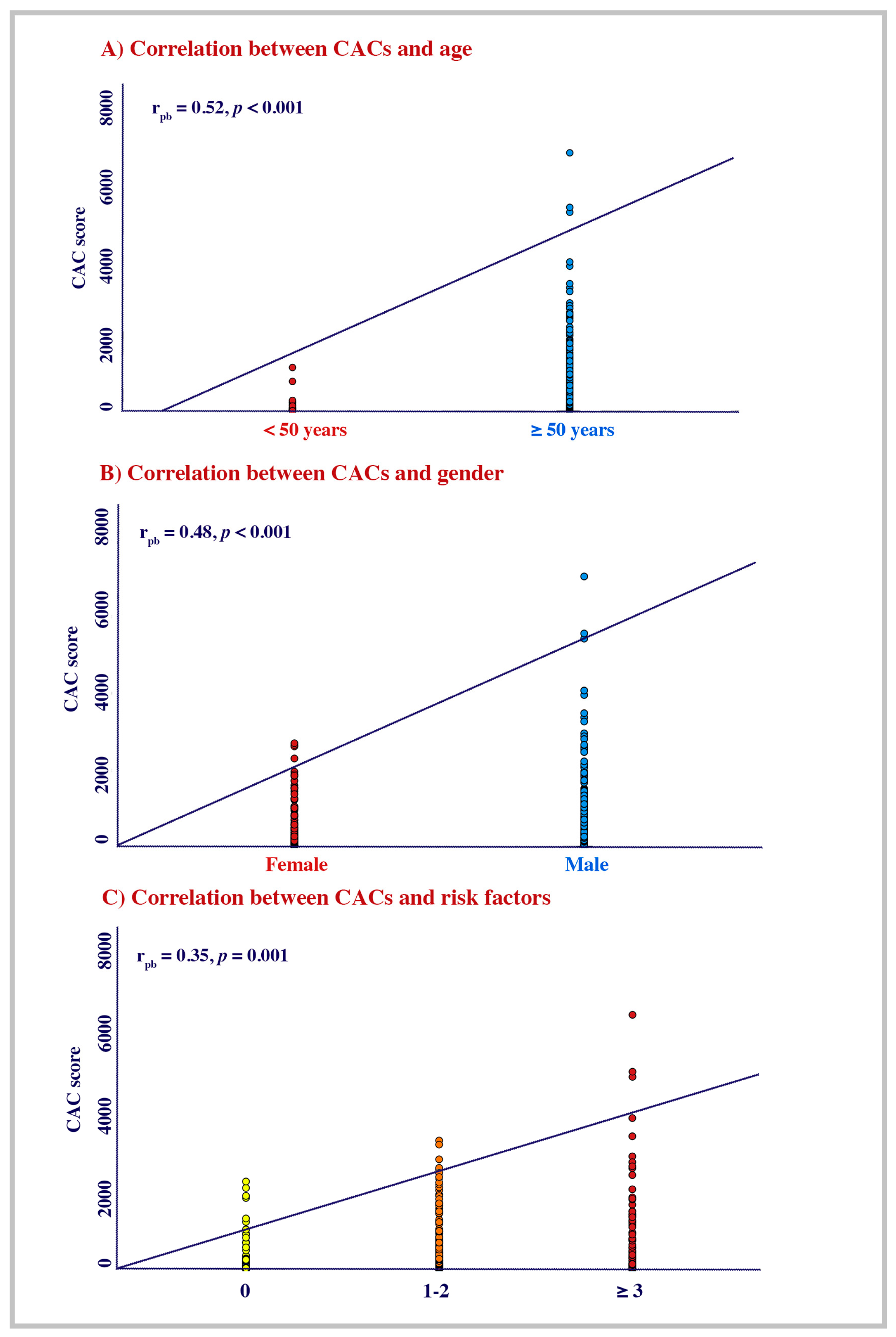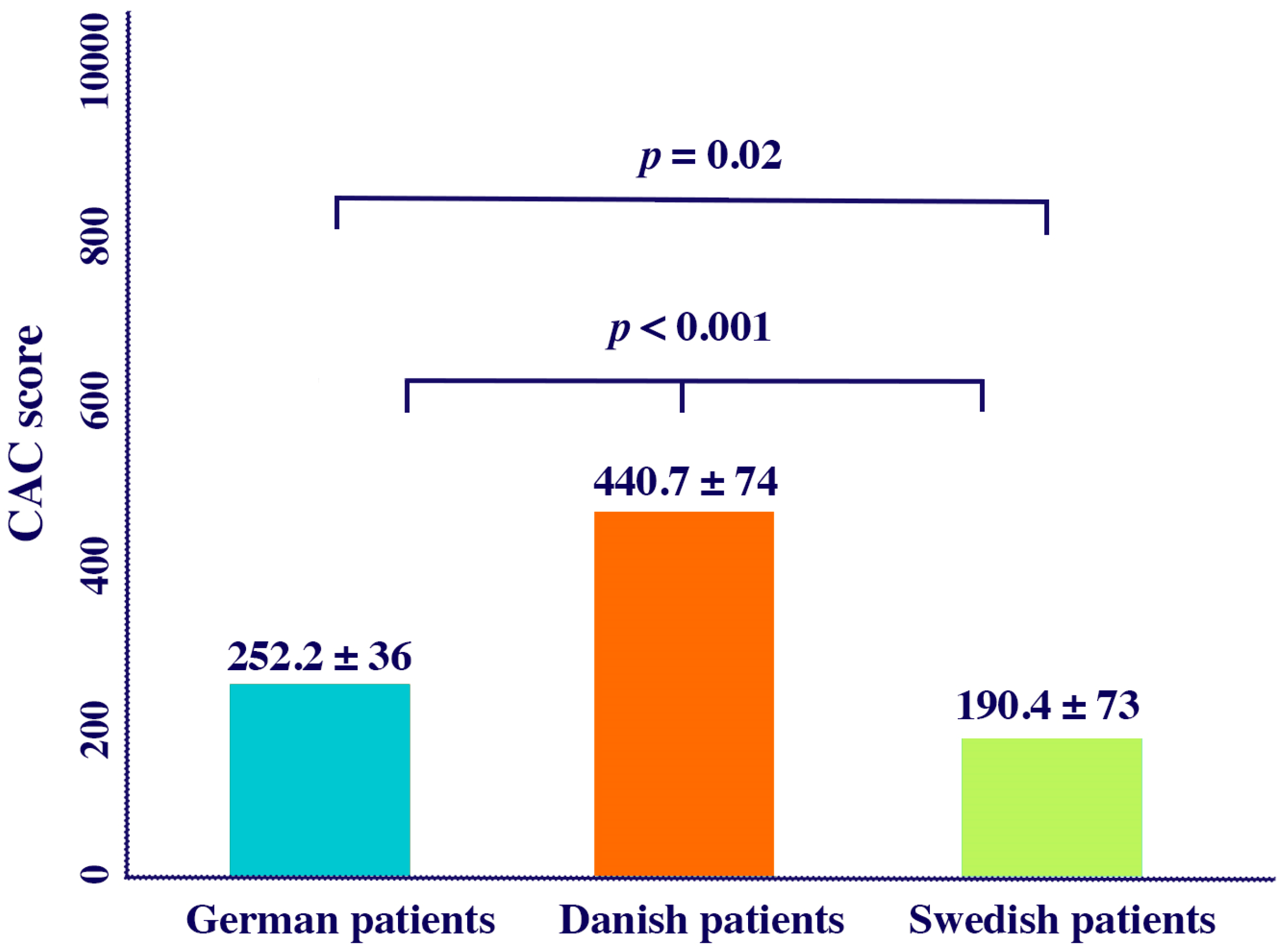Hypercholesterolemia Is the Only Risk Factor Consistently Associated with Coronary Calcification in Three European Countries—Euro CCAD Study †
Abstract
1. Introduction
2. Methods
2.1. Study Design and Patients
2.2. Cardiovascular Risk Factor Assessment
2.3. Coronary Artery Calcium (CACs)
2.4. Statistical Analysis
3. Results
3.1. Demographic Indices
3.2. Impact of CV Risk Factors on CACs
3.3. The Relationship Between Ethnicity, CV Risk, and CACs
3.4. Correlates with CACs
4. Discussion
Author Contributions
Funding
Institutional Review Board Statement
Informed Consent Statement
Data Availability Statement
Conflicts of Interest
References
- Vancheri, F.; Longo, G.; Vancheri, S.; Danial, J.S.H.; Henein, M.Y. Coronary Artery Microcalcification: Imaging and Clinical Implications. Diagnostics 2019, 9, 125. [Google Scholar] [CrossRef]
- Tegegne, T.K.; Islam, S.M.S.; Maddison, R. Longitudinal patterns of lifestyle risk behaviours among UK adults with established cardiovascular disease: A latent transition analysis. Front Cardiovasc. Med. 2023, 10, 1116905. [Google Scholar] [CrossRef] [PubMed]
- Lenselink, C.; Ties, D.; Pleijhuis, R.; van der Harst, P. Validation and comparison of 28 risk prediction models for coronary artery disease. Eur. J. Prev. Cardiol. 2022, 29, 666–674. [Google Scholar] [CrossRef]
- Hecht, H.; Blaha, M.J.; Berman, D.S.; Nasir, K.; Budoff, M.; Leipsic, J.; Blankstein, R.; Narula, J.; Rumberger, J.; Shaw, L.J. Clinical indications for coronary artery calcium scoring in asymptomatic patients: Expert consensus statement from the Society of Cardiovascular Computed Tomography. J. Cardiovasc. Comput. Tomogr. 2017, 11, 157–168. [Google Scholar] [CrossRef] [PubMed]
- Hulten, E.; Bittencourt, M.S.; Ghoshhajra, B.; O’Leary, D.; Christman, M.P.; Blaha, M.J.; Troung, Q.; Nelson, K.; Montana, P.; Steigner, M.; et al. Incremental prognostic value of coronary artery calcium score versus CT angiography among symptomatic patients without known coronary artery disease. Atherosclerosis 2014, 233, 190–195. [Google Scholar] [CrossRef]
- LaMonte, M.J.; FitzGerald, S.J.; Church, T.S.; Barlow, C.E.; Radford, N.B.; Levine, B.D.; Pippin, J.J.; Givvons, L.W.; Blair, S.N.; Nichaman, M.Z. Coronary artery calcium score and coronary heart disease events in a large cohort of asymptomatic men and women. Am. J. Epidemiol. 2005, 162, 421–429. [Google Scholar] [CrossRef] [PubMed]
- Elias-Smale, S.E.; Proenca, R.V.; Koller, M.T.; Kavousi, M.; van Rooij, F.J.A.; Hunink, M.G.; Steyerberg, E.W.; Hofman, A.; Oudkerk, M.; Witteman, J.C.M. Coronary calcium score improves classification of coronary heart disease risk in the elderly: The Rotterdam study. J. Am. Coll. Cardiol. 2010, 56, 1407–1414. [Google Scholar] [CrossRef]
- Bajraktari, A.; Bytyçi, I.; Henein, M.Y. High Coronary Wall Shear Stress Worsens Plaque Vulnerability: A Systematic Review and Meta-Analysis. Angiology 2021, 72, 706–714. [Google Scholar] [CrossRef]
- Haq, A.; Veerati, T.; Walser-Kuntz, E.; Aldujeli, A.; Tang, M.; Miedema, M. Coronary artery calcium and the risk of cardiovascular events and mortality in younger adults: A meta-analysis. Eur. J. Prev. Cardiol. 2024, 31, 1061–1069. [Google Scholar] [CrossRef]
- Villines, T.C.; Hulten, E.A.; Shaw, L.J.; Goyal, M.; Dunning, A.; Achenbach, S.; Al-Mallah, M.; Berman, D.S.; Budoff, M.J.; Cademartiri, F.; et al. CONFIRM Registry Investigators. Prevalence and severity of coronary artery disease and adverse events among symptomatic patients with coronary artery calcification scores of zero undergoing coronary computed tomography angiography: Results from the CONFIRM (Coronary CT Angiography Evaluation for Clinical Outcomes: An International Multicenter) registry. J. Am. Coll. Cardiol. 2011, 58, 2533–2540. [Google Scholar]
- DeFilippis, A.P.; Blaha, M.J.; Ndumele, C.E.; Budoff, M.J.; Lloyd-Jones, D.M.; McClelland, R.L.; Lakoski, S.G.; Cushman, M.; Wong, N.D.; Blumenthal, R.S.; et al. The association of Framingham and Reynolds risk scores with incidence and progression of coronary artery calcification in MESA (Multi-Ethnic Study of Atherosclerosis). J. Am. Coll. Cardiol. 2011, 58, 2076–2083. [Google Scholar] [CrossRef] [PubMed]
- Nasir, K.; Shaw, L.J.; Liu, S.T.; Weinstein, S.R.; Mosler, T.R.; Flores, P.R.; Raggi, P.; Berman, D.S.; Blumenthal, R.S.; Budoff, M.J. Ethnic differences in the prognostic value of coronary artery calcification for all-cause mortality. J. Am. Coll. Cardiol. 2007, 50, 953–960. [Google Scholar] [CrossRef]
- Bajraktari, A.; Bytyçi, I.; Diederichsen, A.; ∙Schmermund, A.; Henein, M. Hypercholesterolemia is sole predictor of coronary calcification in three European countries—Euro CCAD study. Atherosclerosis 2024, 395, 117701. [Google Scholar] [CrossRef]
- Stanford, W.; Thompson, B.H.; Weiss, R.M. Coronary artery calcification: Clinical significance and current methods of detection. AJR Am. J. Roentgenol. 1993, 161, 1139–1146. [Google Scholar] [CrossRef] [PubMed]
- Bengrid, T.; Nicoll, R.; Zhao, Y.; Schmermund, A.; Henein, M.Y. Coronary calcium score is superior to exercise tolerance testing in predicting significant coronary artery stenosis. Int. J. Cardiol. 2013, 168, 1697–1699. [Google Scholar] [CrossRef]
- Faggiano, P.; Dasseni, N.; Gaibazzi, N.; Rossi, A.; Henein, M.; Pressman, G. Cardiac calcification as a marker of subclinical atherosclerosis and predictor of cardiovascular events: A review of the evidence. Eur. J. Prev. Cardiol. 2019, 26, 1191–1204. [Google Scholar] [CrossRef]
- Al-Kindi, S.; Dong, T.; Chen, W.; Tashtish, N.; Neeland, I.J.; Nasir, K.; Rajagopalan, S. Relation of coronary calcium scoring with cardiovascular events in patients with diabetes: The CLARIFY Registry. J. Diabetes Complicat. 2022, 36, 108269. [Google Scholar] [CrossRef]
- Nicoll, R.; Wiklund, U.; Zhao, Y.; Diederichsen, A.; Mickley, H.; Ovrehus, K.; Zamorano, J.; Gueret, P.; Schmermund, A.; Maffei, E.; et al. Gender and age effects on risk factor-based prediction of coronary artery calcium in symptomatic patients: A Euro-CCAD study. Atherosclerosis 2016, 252, 32–39. [Google Scholar] [CrossRef]
- Nicoll, R.; Wiklund, U.; Zhao, Y.; Diederichsen, A.; Mickley, H.; Ovrehus, K.; Zamorano, P.; Gueret, P.; Schmermund, A.; Maffei, E.; et al. The coronary calcium score is a more accurate predictor of significant coronary stenosis than conventional risk factors in symptomatic patients: Euro-CCAD study. Int. J. Cardiol. 2016, 207, 13–19. [Google Scholar] [CrossRef]
- Erbel, R.; Lehmann, N.; Churzidse, S.; Rauwolf, M.; Mahabadi, A.A.; Möhlenkamp, S.; Moebus, S.; Bauer, M.; Kalsch, H.; Budde, T.; et al. Heinz Nixdorf Recall Study Investigators. Progression of coronary artery calcification seems to be inevitable, but predictable–Results of the Heinz Nixdorf Recall (HNR) study. Eur. Heart J. 2014, 35, 2960–2971. [Google Scholar] [CrossRef]
- Loria, C.M.; Liu, K.; Lewis, C.E.; Hulley, S.B.; Sidney, S.; Schreiner, P.J.; Williams, O.D.; Bild, D.E.; Detrano, R. Early adult risk factor levels and subsequent coronary artery calcification: The CARDIA Study. J. Am. Coll. Cardiol. 2007, 49, 2013–2020. [Google Scholar] [CrossRef] [PubMed]
- Bild, D.E.; Bluemke, D.A.; Burke, G.L.; Detrano, R.; Diez Roux, A.V.; Folsom, A.R.; Greenland, P.; Jacobs, D.R.; Kronmal, R.; Liu, K.; et al. Multi-Ethnic Study of Atherosclerosis: Objectives and design. Am. J. Epidemiol. 2002, 156, 871–881. [Google Scholar] [CrossRef] [PubMed]
- Onnis, C.; Virmani, R.; Kawai, K.; Nardi, V.; Lerman, A.; Cademartiri, F.; Scicolone, R.; Boi, A.; Congiu, T.; Faa, G.; et al. Coronary Artery Calcification: Current Concepts and Clinical Implications. Circulation 2024, 149, 251–266. [Google Scholar] [CrossRef] [PubMed]
- Henein, M.; Granåsen, G.; Wiklund, U.; Schmermund, A.; Guerci, A.; Erbel, R.; Raggi, P. High dose and long-term statin therapy accelerate coronary artery calcification. Int. J. Cardiol. 2015, 184, 581–586. [Google Scholar] [CrossRef]
- Shahraki, M.N.; Jouabadi, S.M.; Bos, D.; Stricker, B.H.; Ahmadizar, F. Statin Use and Coronary Artery Calcification: A Systematic Review and Meta-analysis of Observational Studies and Randomized Controlled Trials. Curr. Atheroscler. Rep. 2023, 25, 769–784. [Google Scholar] [CrossRef]
- Savo, M.T.; De Amicis, M.; Cozac, D.A.; Cordoni, G.; Corradin, S.; Cozza, E.; Amato, F.; Lassandro, E.; Da Pozzo, S.; Tansella, D.; et al. Comparative Prognostic Value of Coronary Calcium Score and Perivascular Fat Attenuation Index in Coronary Artery Disease. J. Clin. Med. 2024, 13, 5205. [Google Scholar] [CrossRef]



| Variable | Patients |
|---|---|
| (n = 550) | |
| Demographic and clinical data | |
| Age (years) | 61.9 ± 12 |
| Age < 50 years (n, %) | 95 (17.3) |
| Females (n, %) | 271 (49.3) |
| BMI (m/kg2) | 27.1 ± 4.1 |
| SBP (mmHg) | 144 ± 18 |
| DBP (mmHg) | 83 ± 10 |
| Individuals living with obesity (n, %) | 130 (23.7) |
| AH (n, %) | 322 (53.5) |
| DM (n, %) | 58 (10.5) |
| Hypercholesterolemia (n, %) | 203 (38.2) |
| Statins (n, %) | 184 (36.6) |
| Smoking (n, %) | 97 (17.6) |
| Number of risk factors | |
| 0 risk factor (n, %) | 107 (19.5) |
| 1–2 risk factor (n, %) | 346 (62.9) |
| ≥3 risk factors (n, %) | 95 (17.3) |
| Calcium scoring | 270.3 ± 72 |
| Very low (0–10), (n, %) | 252 (45.6) |
| Low (11–100), (n, %) | 91 (16.5) |
| Intermediate (101–400), (n, %) | 87 (15.8) |
| Severe (>400), (n, %) | 122 (22.2) |
| Variable | German | Danish | Swedish | p |
|---|---|---|---|---|
| Patients | Patients | Patients | Value | |
| (n = 84) | (n = 344) | (n = 122) | ||
| Demographic and clinical data | ||||
| Age (years) | 56.7 ± 10 a*,b* | 71.6 ± 6.7 | 69.8 ± 9.3 | <0.001 |
| Age < 50 years (n, %) | 93 (27) a*,b* | 0 (0) c* | 1 (0.81) | <0.001 |
| Females (n, %) | 175 (50.8) a*,b* | 29 (34.5) | 67 (54.9) | <0.001 |
| BMI (m/kg2) | 26.9 ± 4.2 | 27.1 ± 4.1 | 27.3 ± 4.1 | NS |
| SBP (mmHg) | 140 ± 17 | 145 ± 19 | 143 ± 18 | NS |
| DBP (mmHg) | 84 ± 11 | 86 ± 11 | 78 ± 9.3 | NS |
| Obesity (n, %) | 80 (24.4) | 19 (22.4) | 31 (25.4) | NS |
| AH (n, %) | 138 (40.1) a* | 62 (73.8) c* | 88 (72.1) | 0.04 |
| DM (n, %) | 21 (6.10) | 16 (19.1) | 22 (18.0) | 0.03 |
| Hypercholesterolemia (n, %) | 68 (19.8) a* | 54 (64.2) c* | 82 (67.2) | 0.001 |
| Statins (n, %) | 92 (26.7) a*,b | 44 (51.2) c* | 78 (64) | <0.001 |
| Smoking (n, %) | 79 (22.9) a*,b | 11 (13.1) c* | 8 (6.55) | <0.001 |
| Number of risk factors | ||||
| 0 risk factor (n, %) | 90 (26.1) a*,b | 17 (20.2) c* | 9 (7.37) | 0.004 |
| 1–2 risk factor (n, %) | 218 (63.4) a*,b | 42 (50.0) c* | 90 (73.3) | <0.001 |
| ≥3 risk factors (n, %) | 36 (10.5) a*,b | 25 (29.7) c | 23 (18.8) | 0.02 |
| Calcium score | 252.2 ± 36 a* | 440.7 ± 74 c | 190.4 ± 73 | 0.001 |
| Very low (0–10 AU) | 214 (62.2) a*,b | 13 (15.5) c* | 37 (30.3) | |
| Low (11–100 AU) | 60 (17.4) a | 10 (11.9) c | 20 (16.4) | 0.02 |
| Intermediate (101–400 AU) | 37 (10.8) a,b | 21 (25.0) c | 29 (32.8) | NS |
| Severe (>400 AU) | 33 (9.59) a*,b* | 41 (48.8) c* | 36 (29.5) | NS |
| (a) | ||
| Variable | Univariate Associates | P |
| β (95% CI) | Value | |
| All patients | ||
| Diabetes mellitus | 64.89 (11.02 to 195.3) | 0.041 |
| Arterial hypertension | 236.1 (101.1 to 371.1) | 0.011 |
| Hypercholesterolemia | 168.1 (109.1 to 360.2) | <0.001 |
| Obesity | 18.87 (−129.5 to 167.2) | 0.053 |
| Smoking | −110.1 (−268.3 to 48.22) | 0.013 |
| Risk factors * | 36.07 (11.12 to 121.4) | <0.001 |
| German patients | ||
| Diabetes mellitus | 222.3 (106,8 to 700.1) | 0.291 |
| Arterial hypertension | 207.1 (1.699 to 544.6) | 0.026 |
| Hypercholesterolemia | 118.1 (33.99 to 241.1) | 0.001 |
| Obesity | 6.351 (−19.11 to 5.172) | 0.211 |
| Smoking | −33.11 (−88.44 to 109.2) | 0.301 |
| Risk factors * | 2.204 (0.330 to 2.009) | <0.001 |
| Danish patients | ||
| Diabetes mellitus | 321.1 (−1.291 to 721.3) | 0.331 |
| Arterial hypertension | 221.3 (0.951 to 538.9) | 0.022 |
| Hypercholesterolemia | 331.1 (104.2 to 759.3) | 0.001 |
| Obesity | 99.21 (−0.125 to 251.1) | 0.115 |
| Smoking | −102.3 (−312.4 to 291.1) | 0.211 |
| Risk factors * | 3.131 (0.121 to 2.89) | 0.01 |
| Swedish patients | ||
| Diabetes mellitus | 151.1 (−33.12 to 405.0) | 0.661 |
| Arterial hypertension | 177.1 (0.978 to 272.8) | 0.021 |
| Hypercholesterolemia | 188.2 (104.1 to 522.1) | 0.022 |
| Obesity | 7.110 (−1.118 to 99.21) | 0.331 |
| Smoking | 222.5 (−188.1 to 516.0) | 0.492 |
| Risk factors * | 3.101 (1.088 to 6.219) | <0.001 |
| (b) | ||
| Variable | Multivariate Associates | P |
| β (95% CI) | Value | |
| All patients | ||
| Diabetes mellitus | −124.4 (−314.8 to 65.89) | 0.201 |
| Arterial hypertension | 142.6 (11.25 to 274.1) | 0.030 |
| Hypercholesterolemia | 185.1 (63.11 to 307.1) | 0.003 |
| Obesity | −32.88 (−170.9 to 105.1) | 0.442 |
| Smoking | −163.9 (−311.0 to −16.82) | 0.073 |
| Risk factors * | 3.741 (2.566 to 4.916) | <0.001 |
| German patients | ||
| Diabetes mellitus | 156.8 (−15.68 to 630.6) | 0.311 |
| Arterial hypertension | 144 (−0.168 to 258.8) | 0.073 |
| Hypercholesterolemia | 149.5 (47.13 to 252.1) | 0.011 |
| Obesity | 2.055 (−82.08 to 7.972) | 0.410 |
| Smoking | −59.17 (−156.4 to 38.11) | 0.230 |
| Risk factors * | 1.179 (0.465 to 1.893) | 0.001 |
| Danish patients | ||
| Diabetes mellitus | 542.1 (14.29 to 961.1) | 0.281 |
| Arterial hypertension | 393.9 (−12.51 to 800.4) | 0.056 |
| Hypercholesterolemia | 542.1 (14.29 to 961.1) | 0.031 |
| Obesity | 27.09 (−12.24 to 66.43) | 0.172 |
| Smoking | −377.3 (−856.4 to 101.6) | 0.122 |
| Risk factors * | 1.22 (−0.8823 to 3.336) | 0.254 |
| Swedish patients | ||
| Diabetes mellitus | 58.92 (267.2 to 385.0) | 0.720 |
| Arterial hypertension | 224.4 (−37.01 to 485.8) | 0.061 |
| Hypercholesterolemia | 198.6 (094.7 to 601.9) | 0.043 |
| Obesity | 4.430 (24.18 to 33.04) | 0.751 |
| Smoking | 213.4 (−613.8 to 186.8) | 0.292 |
| Risk factors * | 2.203 (0.717 to 3.689) | 0.004 |
Disclaimer/Publisher’s Note: The statements, opinions and data contained in all publications are solely those of the individual author(s) and contributor(s) and not of MDPI and/or the editor(s). MDPI and/or the editor(s) disclaim responsibility for any injury to people or property resulting from any ideas, methods, instructions or products referred to in the content. |
© 2025 by the authors. Licensee MDPI, Basel, Switzerland. This article is an open access article distributed under the terms and conditions of the Creative Commons Attribution (CC BY) license (https://creativecommons.org/licenses/by/4.0/).
Share and Cite
Bajraktari, A.; Bytyçi, I.; Diederichsen, A.; Schmermund, A.; Henein, M.Y. Hypercholesterolemia Is the Only Risk Factor Consistently Associated with Coronary Calcification in Three European Countries—Euro CCAD Study. Diagnostics 2025, 15, 2789. https://doi.org/10.3390/diagnostics15212789
Bajraktari A, Bytyçi I, Diederichsen A, Schmermund A, Henein MY. Hypercholesterolemia Is the Only Risk Factor Consistently Associated with Coronary Calcification in Three European Countries—Euro CCAD Study. Diagnostics. 2025; 15(21):2789. https://doi.org/10.3390/diagnostics15212789
Chicago/Turabian StyleBajraktari, Artan, Ibadete Bytyçi, Axel Diederichsen, Axel Schmermund, and Michael Y. Henein. 2025. "Hypercholesterolemia Is the Only Risk Factor Consistently Associated with Coronary Calcification in Three European Countries—Euro CCAD Study" Diagnostics 15, no. 21: 2789. https://doi.org/10.3390/diagnostics15212789
APA StyleBajraktari, A., Bytyçi, I., Diederichsen, A., Schmermund, A., & Henein, M. Y. (2025). Hypercholesterolemia Is the Only Risk Factor Consistently Associated with Coronary Calcification in Three European Countries—Euro CCAD Study. Diagnostics, 15(21), 2789. https://doi.org/10.3390/diagnostics15212789






